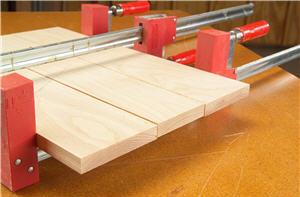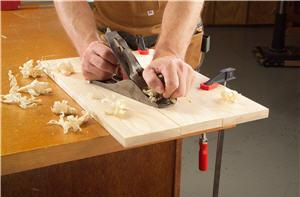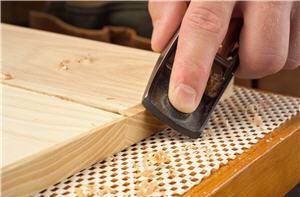
Small chamfers fix a gluing mistake.I'm under the gun. This small end table is the perfect gift for an old college friend, but I only have a couple of days left to complete the task. The only thing left before finishing is to square up and sand the top. Aaaagh! In my haste, I haven't noticed that my woodworking glue-up has slipped and the tabletop is uneven by about 1/16" on the top and bottom.This piece will be too thin if I face the bottom and plane the top perfectly flat. I don't have enough time to go out and buy wood and then wait for it to acclimate to my shop; heck, I don't even have enough time to glue up another panel and wait for it to dry.
What a bind! Now is my chance to borrow an old trick from the Stickley Brothers. In admiring some of their antiques, I've noticed that they truly differentiated between visible and hidden surfaces. I need to do the same here.

Rather than flatten the bottom and top, I decide only to flatten the top. I clamp the work piece to my bench, but bench dogs and a vise would also work great. I use a freshly honed blade and plane in the direction of the wood (Photo 2). Remember, I want to maximize the thickness of the top, so I avoid tear-out as much as possible.

Next, I check the flatness of the panel with a straightedge (Photo 3). Once the tabletop is flat, I square it up, and while doing, so I remove the most uneven parts from the bottom. Then I sand the top to final smoothness.

I chamfer the bottom edge of the work-piece using a hand plane (Photo 4). At first, the planning is a bit choppy as the plane transitions between the uneven boards, but eventually the uneven surface 'disappears' and my plane slides smoothly along the end of the piece. I remove an equal amount from each proud piece to make a consistent chamfer along the end of the board. I continue this chamfer around the perimeter of the piece.

Once the bottom has a consistent chamfer, I flip it over to inspect my work. The unevenness is impossible to see. It does appear a touch thin, so I employ an old visual trick by chamfering the top (Photo 5). I only add a small chamfer, but if I wanted the illusion of a much thicker top, I could plane a larger, wider chamfer.
Discretion should be used when employing this technique, as it is perfect for a small end table, or even for a floating panel in a cabinet, but not for a dining table. The edge of a dining table top is felt and caressed, whereas the inside of a panel or the underside of an end table is rarely seen or handled. Once this piece is affixed to its low table apron, it is truly invisible.
Instead of missing my college buddy's birthday, I'm able to give him his gift on time, thanks to this simple but effective repair.
Photos By Mike Krivit


Alles super
Thank you for this!! I was so disappointed to find two boards had slipped, in the same manner as you described, I'm a walnut and birdseye chess board I'm making for my son. Your fix just saved me time, money and a lot of frustration!
I rub my wood down every night before I sleep!